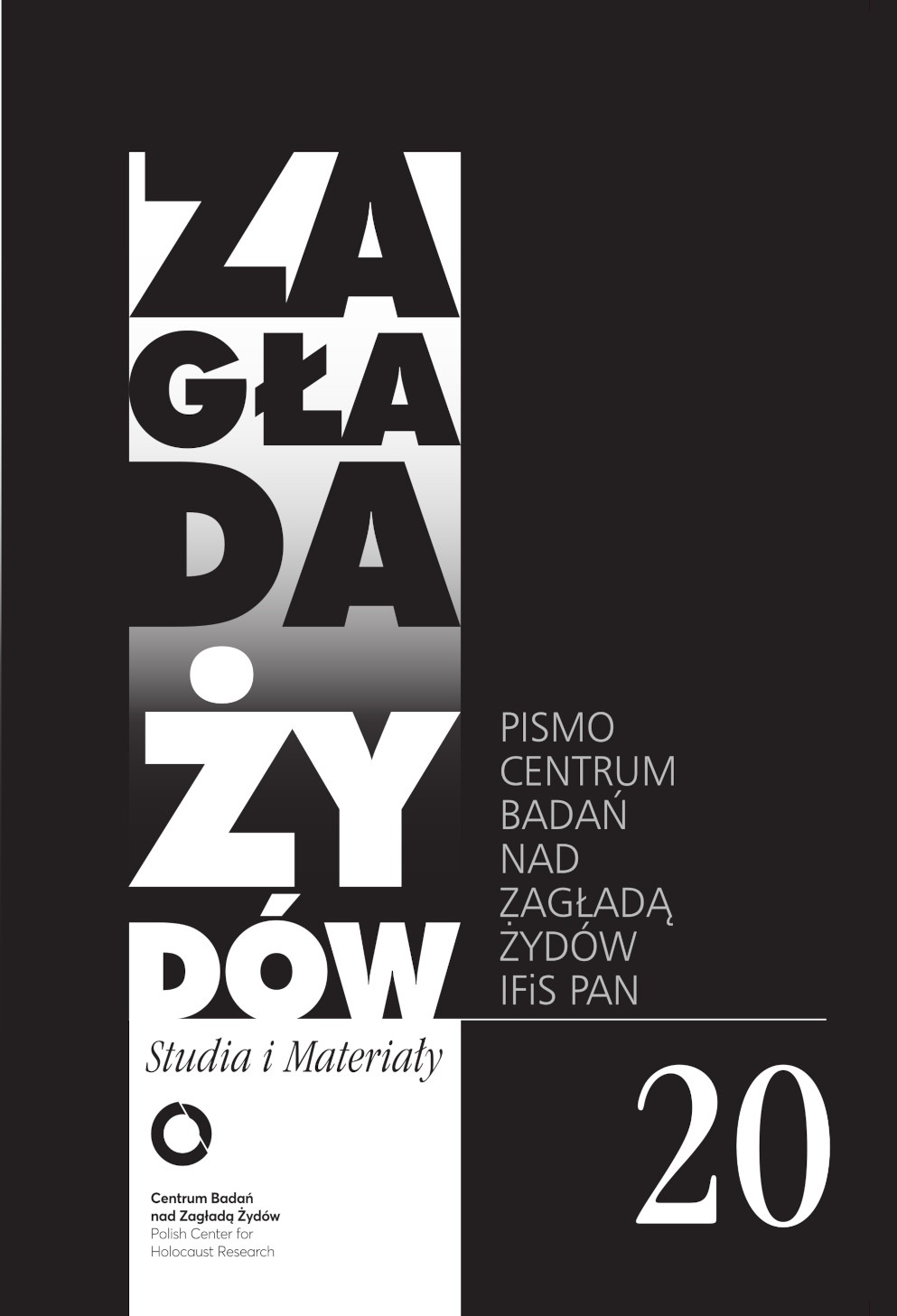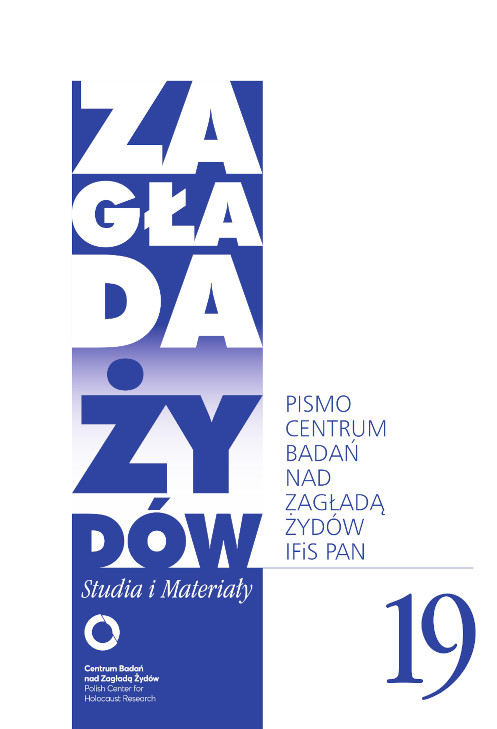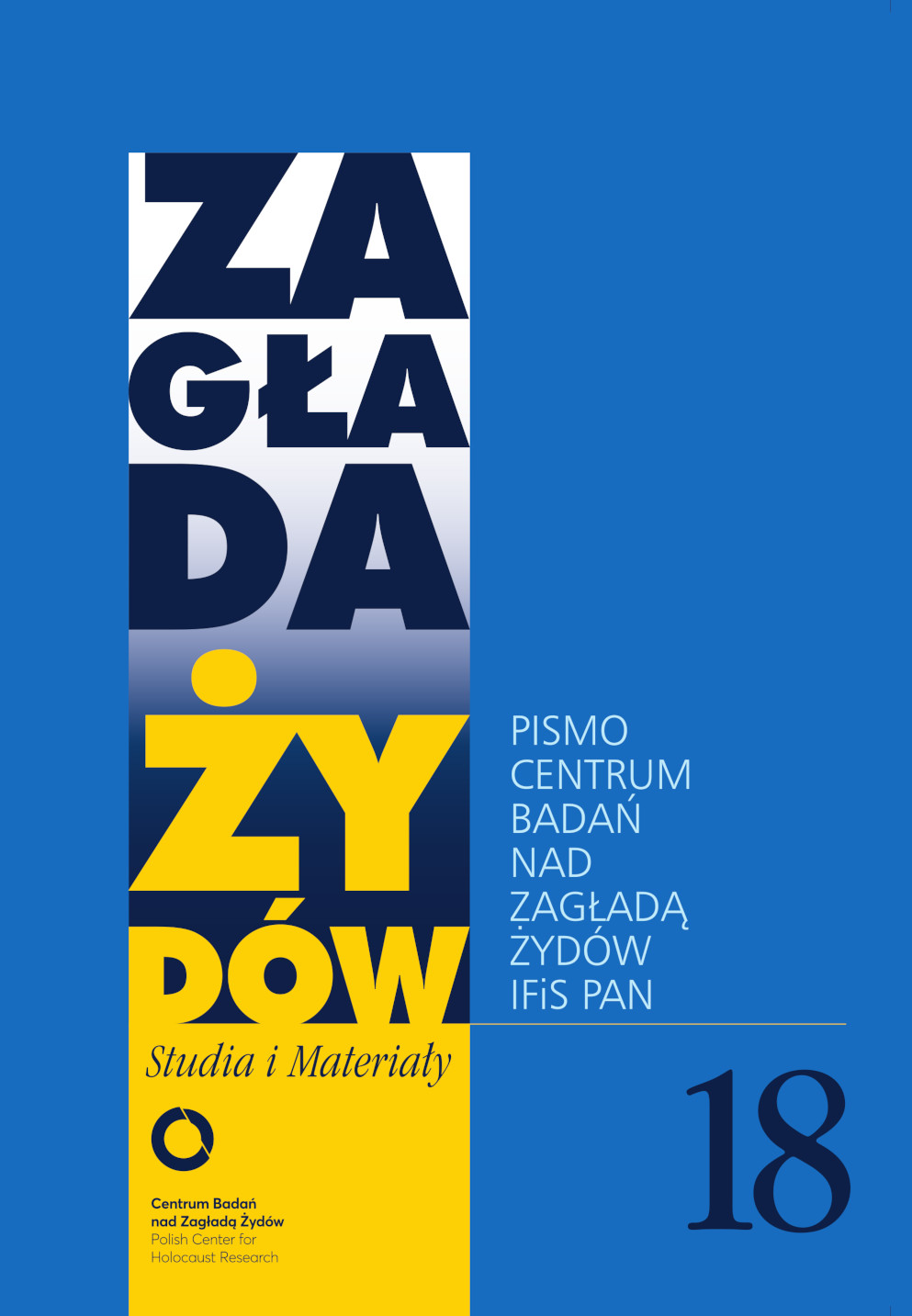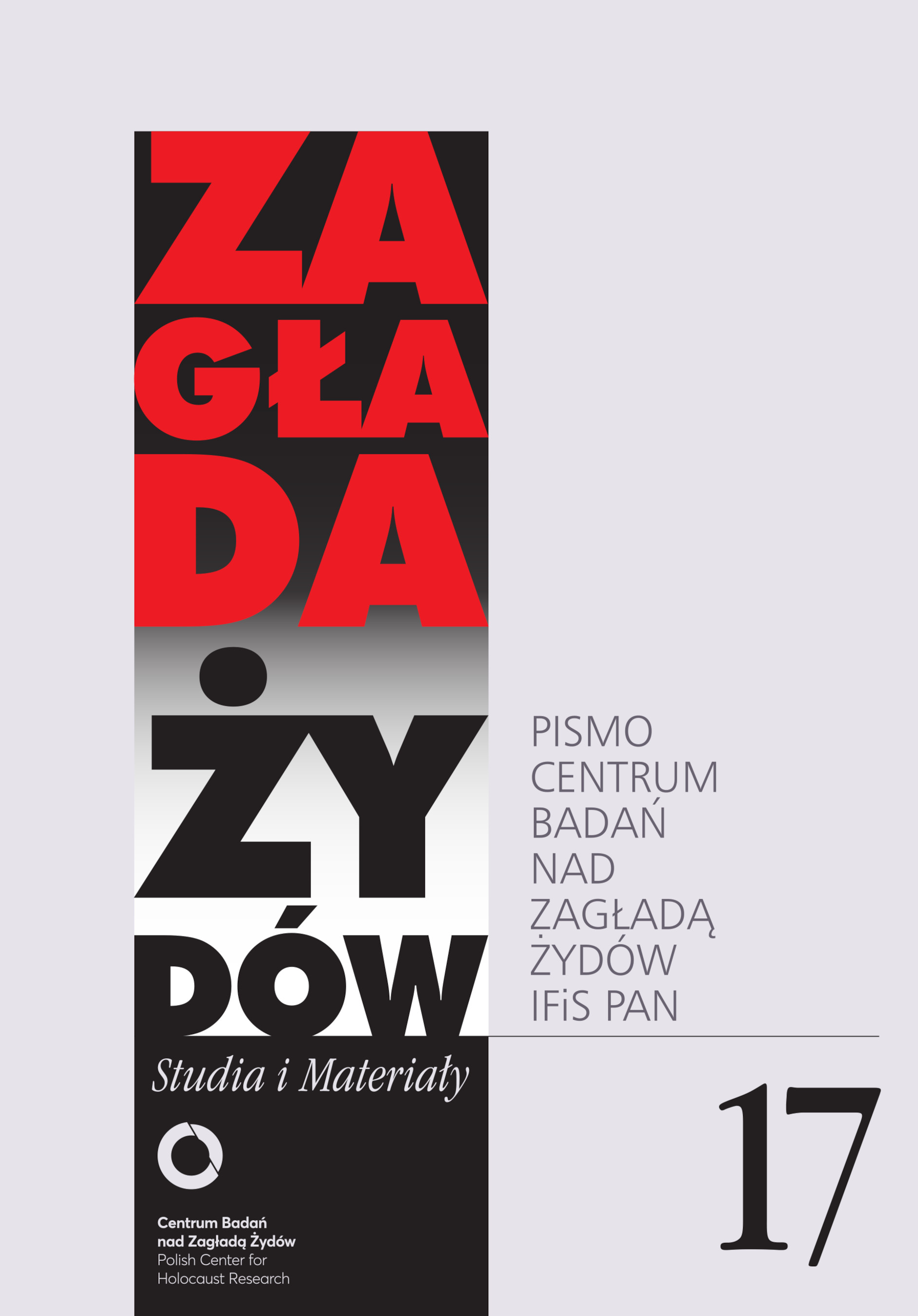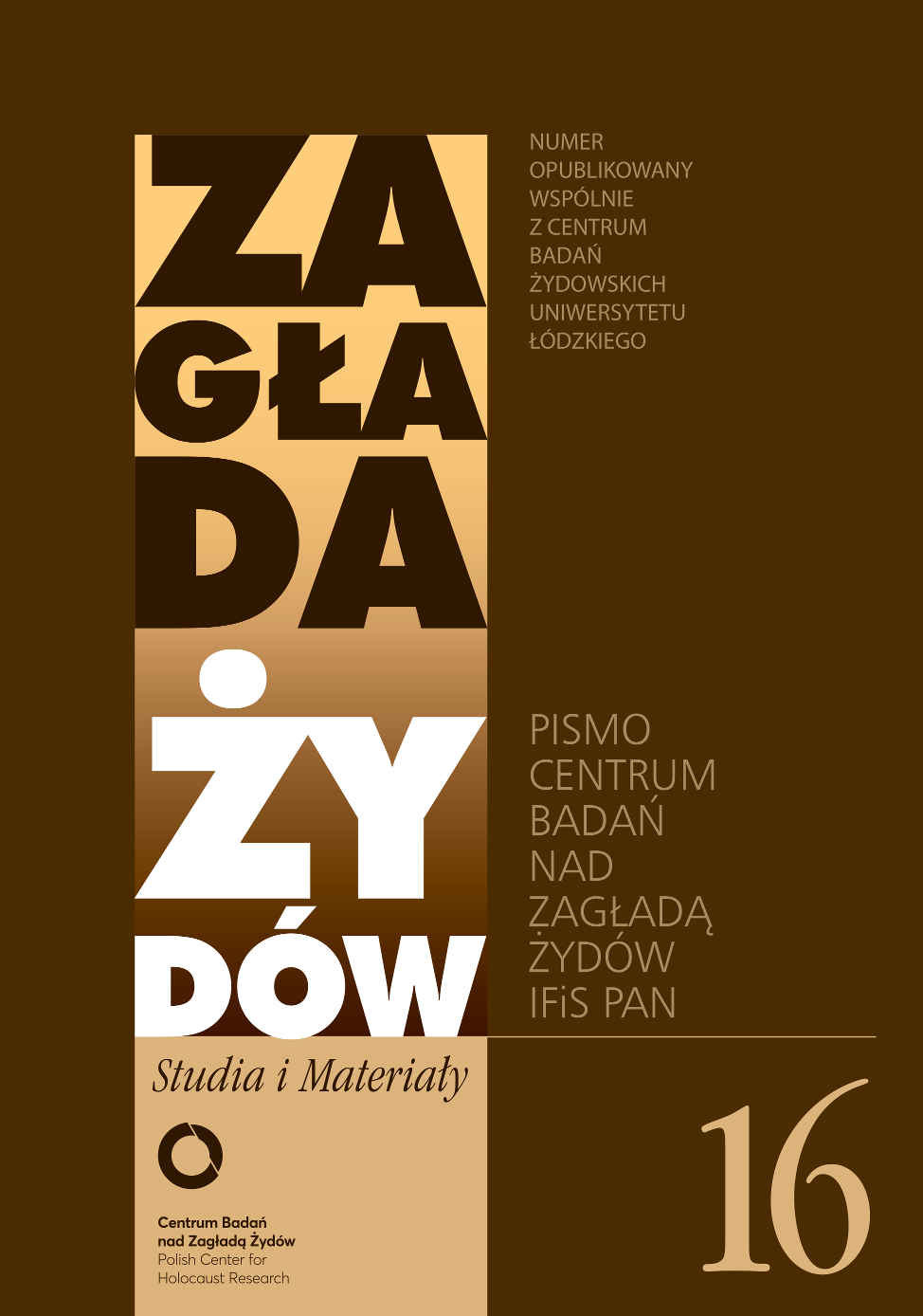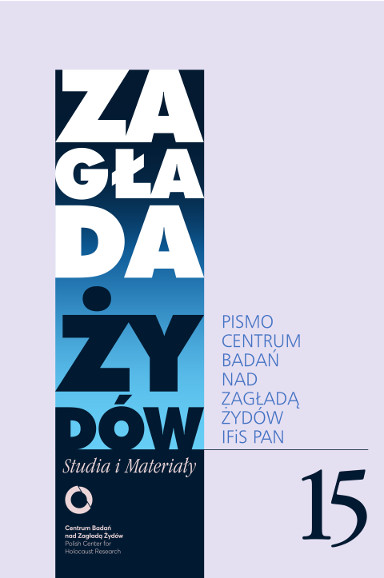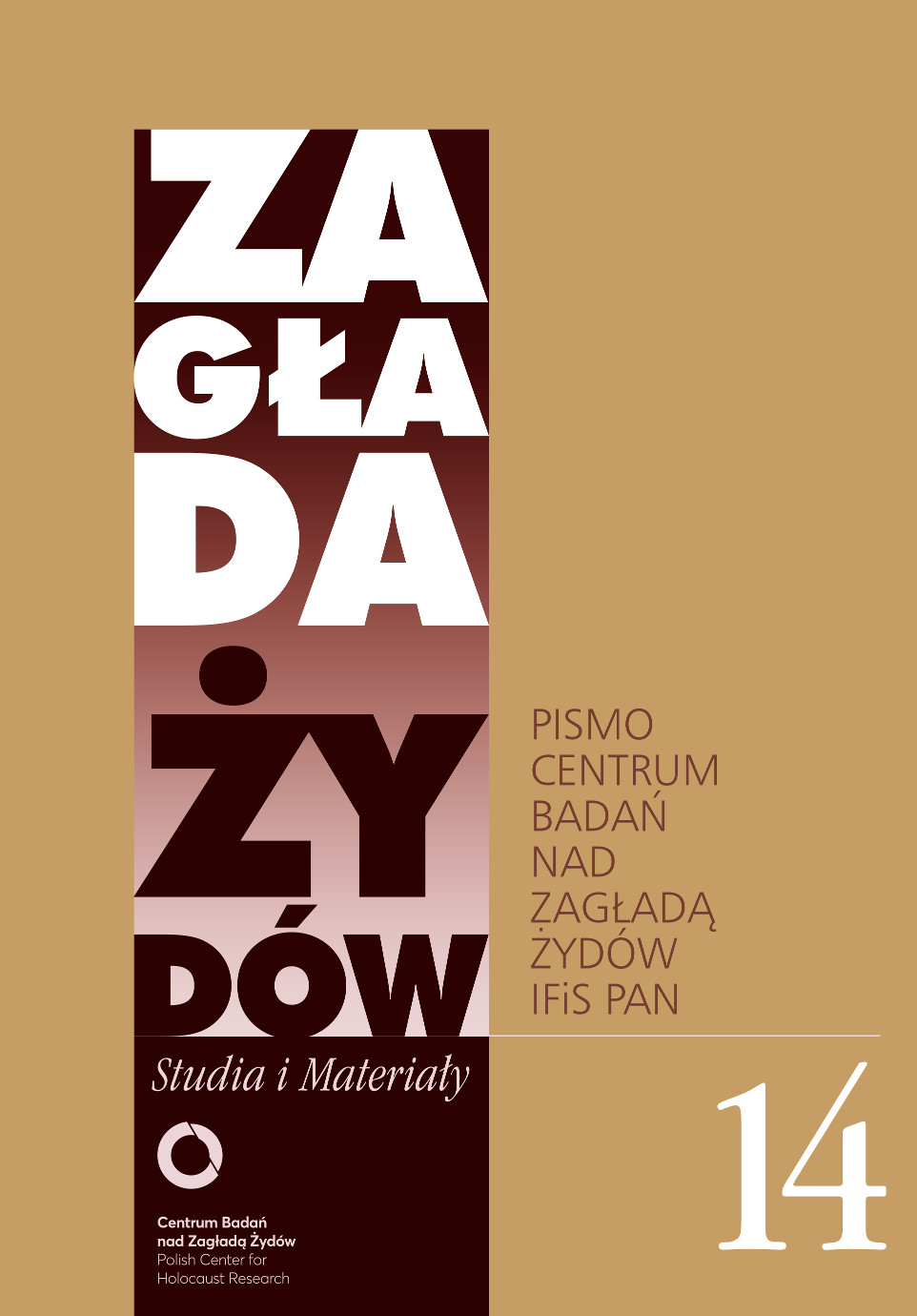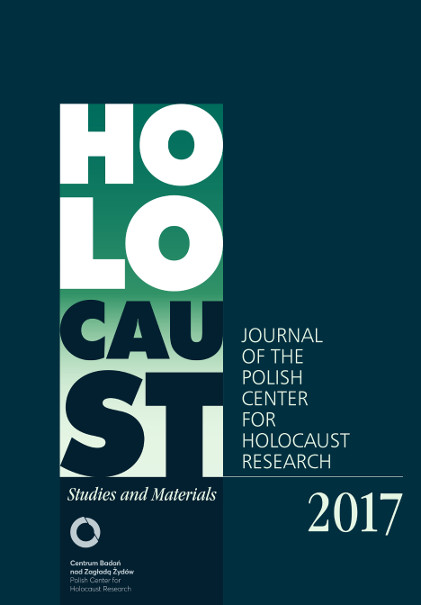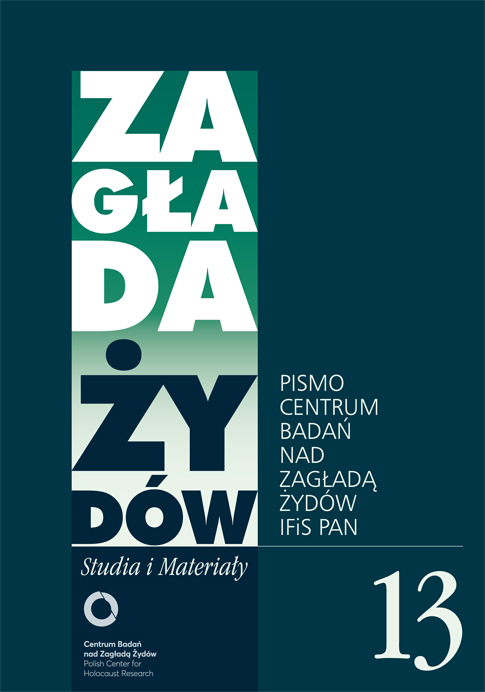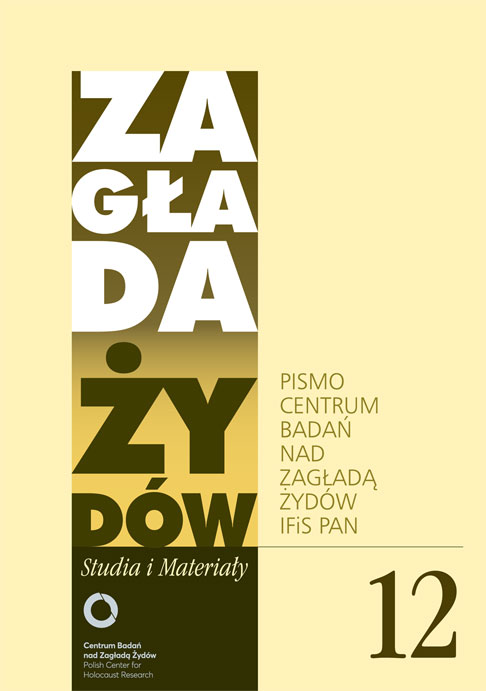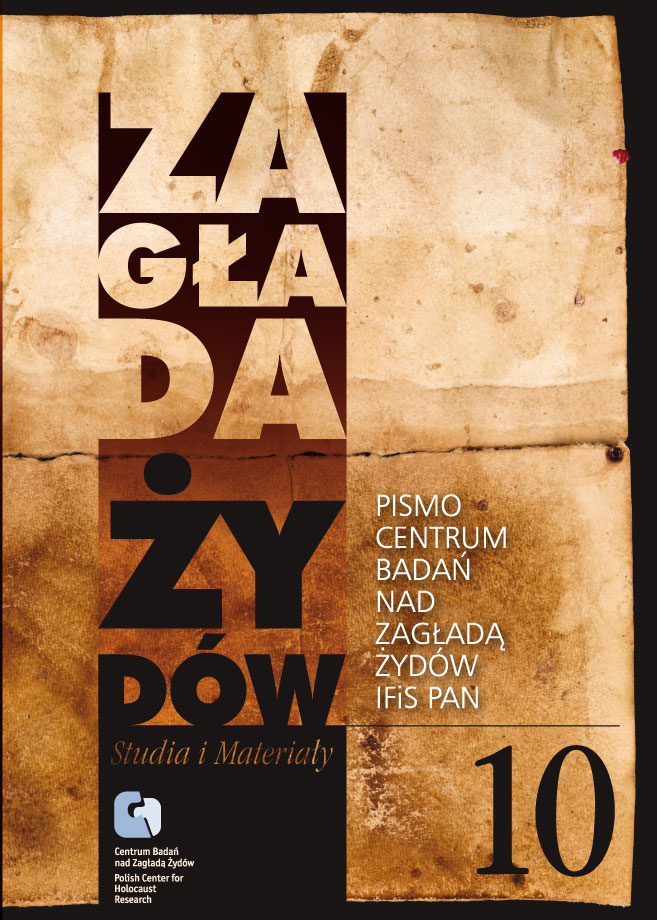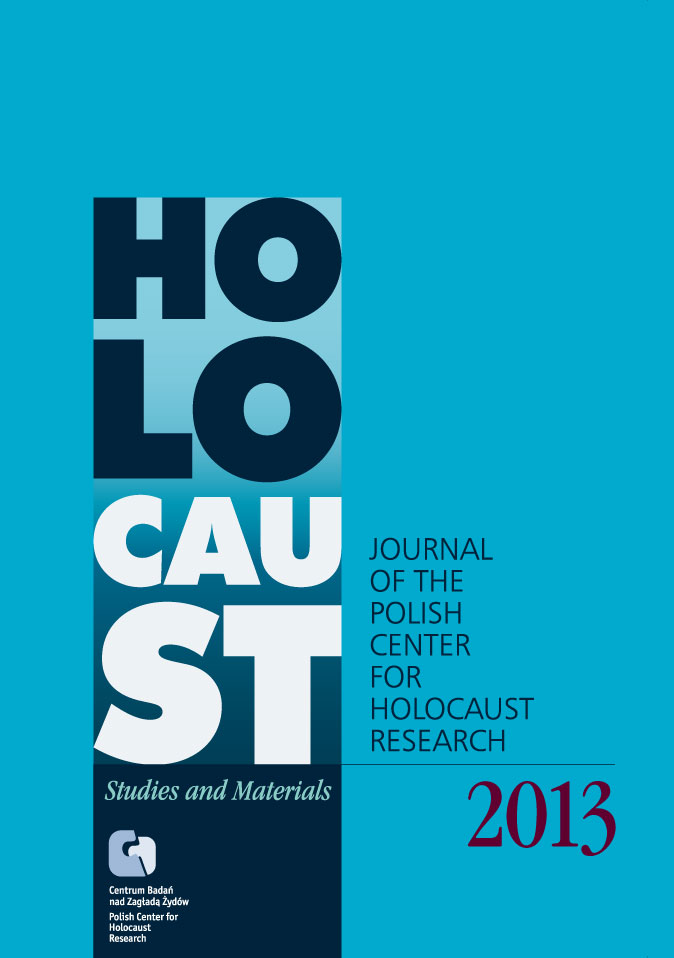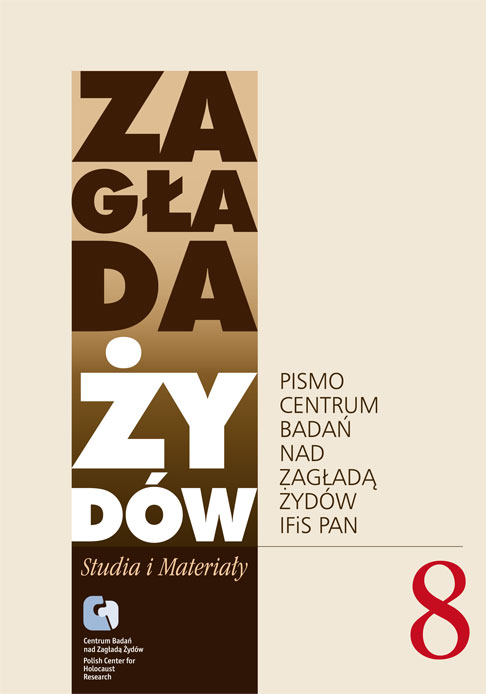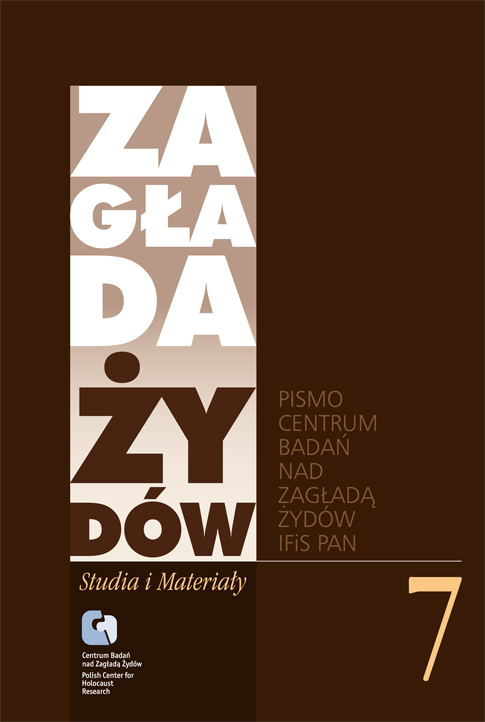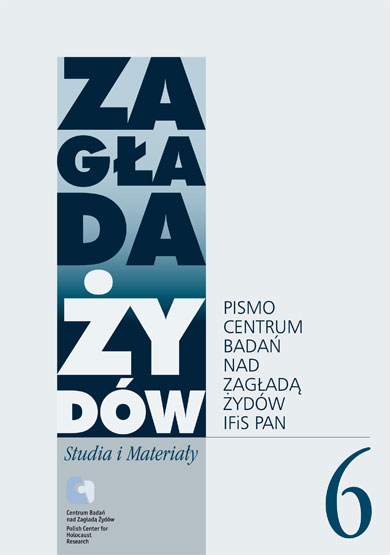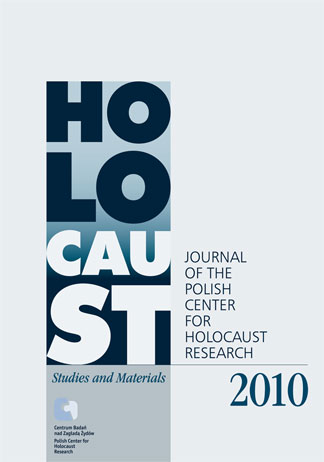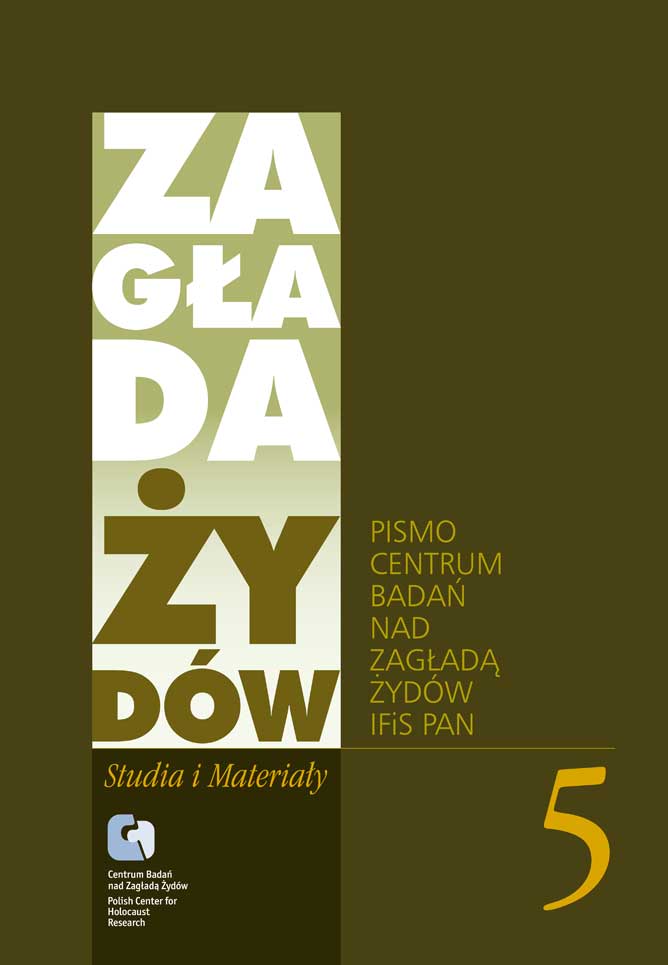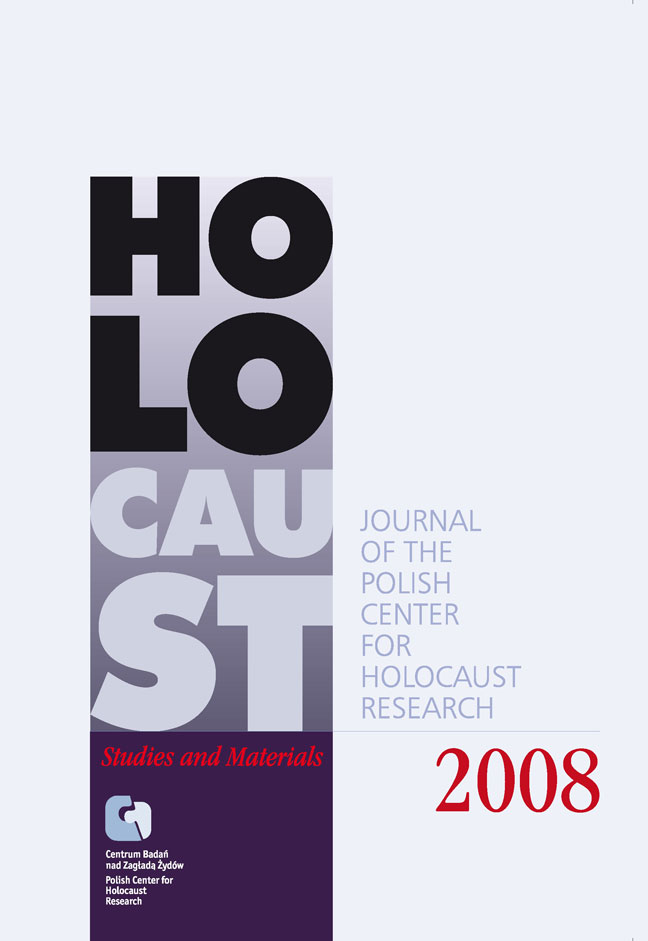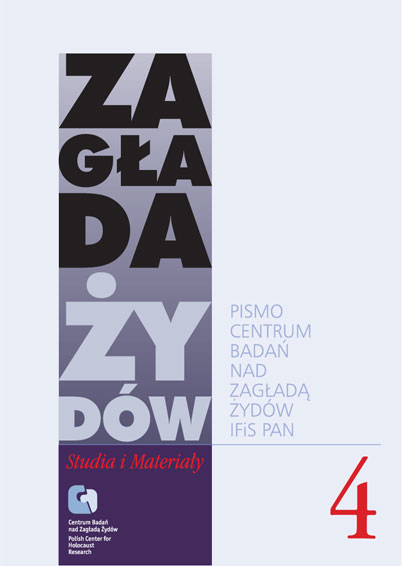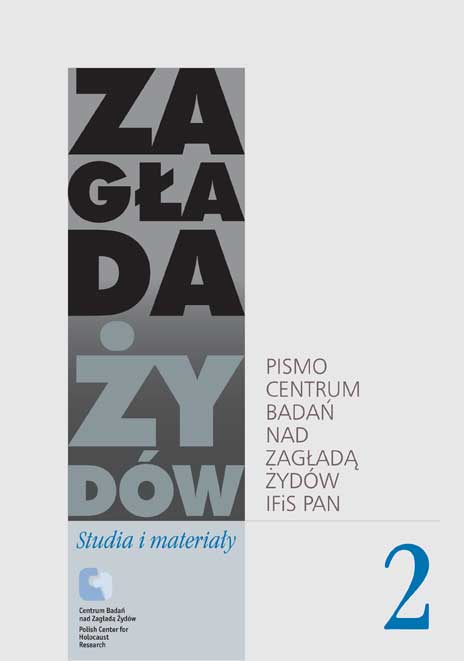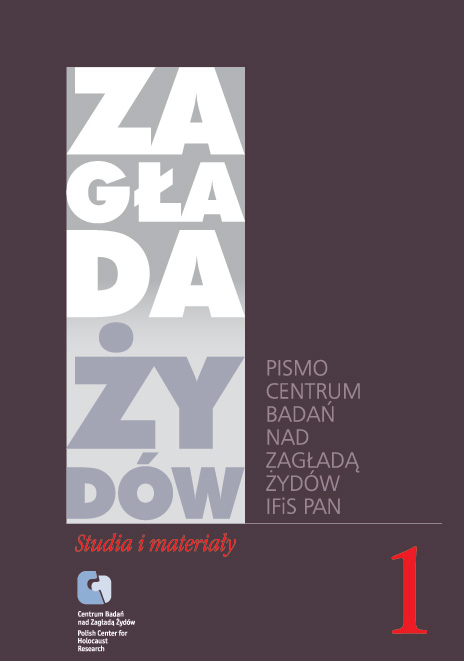Archiwum
Wiodącą tematyką tego numeru jest spotkanie psychologii z historią. Michał Bilewicz i Karolina Marcinkowska opisują ewolucję rozumienia zachowań ofiar, sprawców i świadków w psychologii społecznej. France Grenaudier-Klijn analizuje źródła pisarstwa Anny Langfus, a Stanley S. Seidner bada okupacyjne traumy Dawida Wdowińskiego. Katarzyna Prot-Klinger i Krzysztof Szwajca podejmują temat terapii ocalałych. W numerze znalazła się również analiza postaw Piusa XII oraz dyplomacji watykańskiej wobec informacji o eksterminacji Żydów w latach 1942-1943, autorstwa Moniki Stolarczyk-Bilardie.
Tom składa się z dwóch bloków tematycznych: 80. rocznicy powstania w getcie warszawskim i powojennych rozliczeń. Nawiązując do rocznicy publikujemy m.in. artykuły Havi Dreifuss o Komendzie Żydowskiej Organizacji Bojowej, Jacka Leociaka o upamiętnieniach rocznicowych, Zapiski Poli Elster i Hersza Berlińskiego z lat 1943–1944 oraz tekst Noama Rachmilewicza o archiwum Żydowskiego Komitetu Narodowego. W dziale Studia Markus Roth pisze o ekstradycjach przestępców wojennych i procesach urzędników, zaś Dariusz Libionka przybliża temat powojennych postępowań wobec policjantów, urzędników i innych z Kreis Miechów. Tomasz Frydel rzuca światło ta zagadnienie sołtysów i ich roli w systemie okupacyjnym, a Ewa Koźmińska-Frejlak o kobietach i osądzaniu przestępstw wobec nich przez Sąd Społeczny.
Bieżący numer naszego rocznika jest poświęcony szeroko pojętej problematyce ucieczek przed Zagładą. Haniebny atak rządzonej przez Władimira Putina Rosji na Ukrainę i jej mieszkańców uczynił tę kwestę dramatycznie aktualną. Od początku wojny rozpoczętej 24 lutego 2022 r. granice Polski przekraczały setki tysięcy uchodźców z terenów okupowanych i zagrożonych przez bezprecedensowy w XXI w. w Europie terror ze strony agresorów.
Wybranie ucieczek jako najważniejszej tematyki tomu zostało podyktowane nie bieżącym kontekstem (agresji rosyjskiej nie mogliśmy przewidzieć, projektując ten numer), lecz wagą tego zagadnienia, prowokującego do stawiania rozmaitych pytań badawczych. Dotyczą one na przykład sposobów i możliwości szacowania ogólnej liczby uciekinierów z gett i szans ich przetrwania.
Tematem przewodnim nowego tomu czasopisma „Zagłada Żydów. Studia i Materiały” są kicz holokaustowy i nadużycia w przedstawianiu Zagłady. W debacie zabrali głos uczeni reprezentujący różne dziedziny nauki i ukazujący problem z wielu perspektyw. W tomie znalazły się między innymi teksty analizujące obraz Zagłady w grach komputerowych i mediach społecznościowych, a także w literaturze pięknej.
Odrębny blok materiałów dotyczy twórczości Artura Żmijewskiego i jego filmu Berek, który stał się przedmiotem gorących dyskusji i został uwikłany w gry polityczne. Na łamach „Zagłady Żydów” po raz pierwszy prezentujemy unikatową kolekcję zdjęć zrobionych podczas realizacji Berka.
Poza tematem przewodnim numer zawiera między innymi nowy głos w dyskusji o postawach policji granatowej wobec Żydów, wyniki badań na temat powojennego plądrowania terenu obozu zagłady w Treblince oraz artykuł o losach Romów i Sinti przesiedlonych do łódzkiego getta.
Tematem przewodnim 16. numeru rocznika jest 75. rocznica likwidacji likwidacji getta łódzkiego. Publikujemy m.in wspomnienia Mariana Turskiego, studium Andrzeja Czyżewskiego o polityce historycznej władź PRL dot. getta, artykuł Ewy Wiatr o grupach młodzieżowych na Marysinie, tekst Irminy Gadowskiej o malarzach. Adriana Bryk przedstawia historią poczty, a Krystyna Radziszewska opisuje losy Żydów europejskich deportowanych do getta, Andrzej Grzegorczyk omawia organizację pierwszej fali deportacji z getta Jacek Walicki porównuje funkcjonujące w gettach archiwów a Sylweriusz Królak analizuje opisy spacerów po obu gettach. Publikujemy też dziennik z getta Viktora Hahna i relację Mordechaja Żurawskiego.
Numer opublikowany wspólnie z Centrum Badań Żydowskich Uniwersytetu Łódzkiego. Do zespołu redakcyjnego gościnnie dołączyli dr Ewa Wiatr oraz dr Adam Sitarek.
Studia i opracowania źródłowe z oddawanego do rąk czytelników 15 numeru rocznika prezentują przede wszystkim sylwetki myślicieli religijnych, rabinów, a także po prostu wierzących Żydów działających w czasie wojny oraz ich pisma: komentowane i poddawane interpretacji. Havi Dreifuss z Yad Vashem przybliża postać „nieznanego przywódcy nieznanego ruchu chasydzkiego w czasie Zagłady” – Matysa Gelmana. O słynnych kazaniach rabina Kalonimusa Kalmana Szapiry wygłaszanych w warszawskim getcie pisze Daniel Reiser. Barbara Krawcowicz przedstawia wątki teodycei w wojennych kazaniach bratysławskiego rabina Szlomy Zalmana Unsdorfera. Adam Kopciowski odnajduje problematykę Boga i Zagłady w listach rabina Hersza Majlecha Talmuda z lubelskiego getta. List rabina Jakuba Szulmana z Grabowa analizuje Adam Sitarek ...
Numer 14. rocznika ukazuje się w roku ważnych rocznic – 75. rocznicy powstania w warszawskim getcie oraz 50. rocznicy Marca 1968. Wokół pierwszego z tych wydarzeń osnuty jest tekst jednego z najważniejszych żyjących badaczy Zagłady – Yehudy Bauera, który z jednej strony przypomina historię powstania i podsumowuje najnowsze ustalenia historyków, z drugiej zaś umieszcza zryw warszawskich Żydów w kontekście relacji i odniesień polsko-żydowskich. Autor omawia ponadto procesy instrumentalizacji pamięci o powstaniu i wykorzystywania jej do doraźnych celów zarówno w Izraelu, jak i w Polsce.
This volume contains a selection of articles from Holocaust. Studies and Materials published by the Centre for Holocaust Research during 2014–2016. This is already the fourth English volume intended to familiarise the foreign reader with the newest Polish research on the Holocaust and also introducing unknown documents from Polish archives into scholarly circulation. The previous editions were published in 2008, 2010, and 2013.
The several dozen texts in this volume are arranged in an order modelled on the Polish-language version, though it was decided not to include a selection of the reviews printed in our periodical.
The first section, Studies, contains six texts. The article opening this volume is Jan Grabowski’s text that reveals new facts regarding the March 1944 discovery of the bunker where Emanuel Ringelblum, the Oneg Shabbat founder, was hiding. This study sheds new light on the mechanism of tracking down Jews in Warsaw. Grabowski’s analysis of post-war court files proves that specialised groups of criminal police functionaries played an extremely active role in those efforts. Barbara Engelking’s study, which also regards the Warsaw context, discusses the help provided to about a dozen Jews by a pre-war avowed anti-Semite. It is not a simple and unambiguous case, however, because after the war that Pole was tried for having acted to the detriment of other Jews. Another of our authors, Dariusz Libionka, presents the reactions of the Polish Government in exile, its consulting body, the National Council of Poland, and the Polish press published in London to the struggle waged by the Warsaw ghetto in April and May 1943. Libionka analyses the reasons for the classification of the initial news from the ghetto, and the Polish authorities’ and also the émigré political circles’ distance towards the fighting Jews. He also discusses the fact of the propaganda taking advantage of Szmul Zygielbojm’s death and Jewish resistance.
The article devoted to the post-war violence against Jews in the Podhale region of Poland deserves special attention. This topic has long inspired heated emotions and has become radically politicised. Suffice it to say that Józef Kuraś ’Ogień’, whose subordinates conducted most of the massacres of the Jews who had just survived the Holocaust, was praised as one of the greatest commanders of the post-war anticommunist underground. One should bear in mind that in 2006 the late Polish President, Lech Kaczyński, ceremonially unveiled Kuraś’s monument in Zakopane. Recreating the course of the consecutive crimes, the author of the text, Karolina Panz, focuses not only on reconstructing their mechanism and perpetrators, but also on the biographies of the victims, convincingly proving that they had nothing to do with communism.
The last two articles in this section were written by Nawojka Cieślińska-Lobkowicz and Elżbieta Janicka. The former concerns organised looting of works of art owned by Jews in the General Government, while the latter discusses the politics of memory and the ways of commemorating Polish and Jewish martyrology in Warsaw. The analysis conducted by Elżbieta Janicka reveals why the monument devoted to Poles murdered in the East during World War II was erected on the former Muranowski Square, where the fiercest fighting in the ghetto went on in April 1943.
Among the texts included in the From Research Workshop section the article about Witold Pilecki is particularly recommended, who has recently become one of the most popular Polish national heroes. According to the dominant narration, Pilecki voluntarily let the Germans deport him in the autumn of 1940 to the Auschwitz concentration camp, which was under construction. The author of this text, Ewa Cuber-Strutyńska, proves that the matter is more complicated, pointing out the discrepancies between different accounts of Pilecki’s arrest. Similarly, the issue of the role of Pilecki’s reports in the transfer of information about the extermination of Jews in the Birkenau gas chambers remains unclear. As we had expected, this text received a particularly cold welcome from nationalist publicists.
In the Materials section we publish the diary of Chaim Einhorn, who was hiding in the Warsaw ghetto, correspondence of members of the German military and police formations that participated in the extermination of the Jews (intercepted by the Home Army intelligence service), and last but not least, reports from several ‘blue’ police stations written during the spring of 1943 (including the period of the Warsaw ghetto uprising).
A separate section is devoted to the POLIN Museum of the History of Polish Jews, opened in 2014. We present the voices of both the creators and the critics of the individual exhibition room’s conception and content.
In the last section, Controversies, overviews are published of the newest publications and actions regarding the Righteous among the Nations. From the point of view of the Polish ‘historical policy’, which strives to subject historical research to political requirements, this is the subject matter most susceptible to manipulations and most often exploited.
13. numer rocznika naukowego „Zagłada Żydów. Studia i Materiały” wydawanego przez Centrum Badań nad Zagładą Żydów IFiS PAN. To prawie dziewięćset stron pionierskich studiów, materiałów, omówień i opracowań nieznanych tekstów źródłowych. Wątkami przewodnimi numeru są dwie rocznice. Pierwsza z nich to 75 rocznica akcji „Reinhardt” czyli eksterminacji Żydów na ziemiach polskich, druga zaś – 70-lecie powstania Żydowskiego Instytutu Historycznego. Tematom tym poświęcono szereg tekstów, które – jak artykuły dotyczące struktur Żydowskiej Samopomocy Społecznej czy badań nad Zagładą prowadzonych w ŻIH w okresie stalinowskim – przedstawiają nieznane szerzej nowe ustalenia historyków. Numer uzupełniają teksty dotyczące m.in. roli formacji pomocniczych w Zagładzie w Galicji Wschodniej i na Litwie czy wyników prowadzonych od lat 70. pionierskich badań etnograficznych nad pamięcią, Znalazły się tu również recenzje najnowszych publikacji oraz komentarze do bieżących wydarzeń.
Wspólnym mianownikiem publikowanych w 12 numerze rocznika artykułów jest kontekst europejski. Zamieszczone teksty dotyczą m.in. zaangażowania francuskiego Kościoła w ukrywanie dzieci żydowskich (Eliot Nidam Orvieto), akcję wysyłania ich do Anglii (Anna M. Rosner), działania Sonderdienst w Genrelanym Gubernatoriskie (Peter Black), a także o postrzegania Żydów przez niemieckich cywilów zatrudnionych w aparacie okupacyjnym (Stephan Lehnstaedt). Szczególnie polecamy artykuł Marty Janczewskiej, która analizując raport Jürgena Stroopa, interpretuje niemiecki język urzędowy opisujący żydowską śmierć. Przybliżamy sylwetki postacie historyczne: „Frankensteina”, sadystycznego policjanta z getta warszawskiego (Jan H. Issinger), antykwariuszy Gutnajerów (Nawojka Cieślińska-Lobkowicz) oraz działacza politycznego, Eleazara Grünbauma (Jacek Dehnel). W dziale „Punkty widzenia” publikujemy m.in. artykuł interpretujący polską literaturę o Zagładzie jako horror (Przemysław Czapliński), oraz teksty inspirowane lekturą Neumannowskiego Behemota (Raul Hilberg) czy porównujący w świetle tej książki faszyzm z komunizmem (Marcin Kula). W obszernym artykule omawiamy głośną książkę Mirosława Tryczyka Miasta śmierci (Krzysztof Persak).
We wstępie redakcja zwraca uwagę na niebezpieczeństwo wynikające z coraz śmielej artykułowanych zapowiedzi radykalnych działań w obszarze tzw. polityki historycznej, a zwłaszcza zagrożenia dla prowadzenia badań naukowych oraz groźbę instrumentalizowania problematyki Holokaustu. Spośród tekstów zamieszczonych w dziale „Studia” na szczególną uwagę zasługuje artykuł Karoliny Panz poświęcony fenomenowi powojennej przemocy na Podhalu. Autorka analizuje przebieg i mechanizm tych zbrodni, lecz przede wszystkim przypomina ich ofiary. Kolejne opracowania dotyczą szerokiego pojętej problematyki pomocy i ratowania: ewakuacji dzieci żydowskich z terenu ZSRR do Palestyny w latach 1942–1943, warunków przetrwania w okupowanej Belgii, Holandii i Francji, pomocy Żydom na terenie Vichy, paradoksów związanych z ukrywaniem Żydów w Warszawie. Dział ten uzupełnia studium o holenderskim naziście prowadzącym zorganizowaną grabież dzieł sztuki. W dziale „Sylwetki” prezentujemy biografię i dorobek kolejnego historyka Zagłady - Filipa Friedmana, zaś w sekcji „Materiały” nieznany dziennik o ukrywaniu po „aryjskiej stronie”.
Do rąk czytelników oddajemy, 10. już numer rocznika naukowego “Zagłada Żydów. Studia i Materiały” wydawanego od 2005 roku przez Centrum Badań nad Zagładą Żydów IFiS PAN. Te 10. lat skłania do syntez, bilansów i podsumowań. W numerze staramy się szukać odpowiedzi na pytania, które rodzi refleksja nad ostatnimi 10. laty badań dot. zagłady Żydów w Polsce - o literaturze i historiografii Zagłady ostatniej dekady piszą Justyna Kowalska-Leder i Bartłomiej Krupa; o obchodach kolejnych rocznic powstania w getcie warszawskim – Piotr Forecki.
10. numer rocznika, prócz podejmowania refleksji wywołanych okrągłą rocznicą rozpoczęcia edycji pisma, poświęcony jest w dużej mierze Warszawie. Jan Grabowski w swoim studium odkrywa ciekaw i nieznane fakt o warszawskim kripo rozpracowującym ukrywających się Żydów; Dariusz Libionka pisze o reakcjach „polskiego Londynu” na powstanie w getcie, Nawojka Cieślinska-Lobkowicz o działającym pomiędzy gettem a stroną aryjską swoistym "antykwariacie" zaś Elżbieta Janicka o symbolicznej topografii terenu dawnego getta. Przypominamy także sylwetki związanych z Warszawą, a zmarłych niedawno prof. Israela Gutmana (pióra Havi Dreyfuss) oraz dr Ruty Sakowskiej (pióra Tadeusza Epszteina) oraz Hersza Wassera Katarzyna Person) i Józefa Kermisza (David Silberklang). W numerze żegnamy także naszego zmarłego nagle kolegę Roberta Kuwałka.
This volume contains texts published during 2011–2013 in the Zagłada Żydów. Studia i Materiały yearly published by the Polish Centre for Holocaust Research, Warsaw. The previous volumes of the English edition were published in 2008 and 2010. The purpose of Holocaust. Studies and Materials is to present the most recent research undertaken in Poland, primarily that based on source materials kept in local archives, in the hope of introducing them to academic circulation. The intention is also to familiarise the foreign reader with the current discussions and disputes in Poland regarding the subject matter of the Holocaust and Polish-Jewish relations.
Four of the texts published in this volume deal with the perception and treatment of the Jews, escapees from the ghettoes and camps, by the partisan detachments of the Home Army and other underground organizations. This subject matter continues to be highly controversial. For instance, after a German TV channel had transmitted the miniseries Generation War [Unsere Mütter, unsere Väter], which shows anti-Semitism spread in the ranks of the Home Army, there was a wave of criticism in Poland.
The studies presented in this volume do not offer a comprehensive analysis of the complex issue of the attitude of the Polish underground resistance to the extermination of the Jews they witnessed. Instead, the studies are multi-faceted analyses of murders committed on the Jews during 1942–1944. The first text, written by historian Alina Skibińska and ethnographer Joanna Tokarska-Bakir, discusses the murders committed on the Jews by members of the famous partisan detachment of the Home Army operating in the Kielce area. The victims included a Jewish family, its Polish helper, who years later received the Righteous among the Nations medal, and a member of a Home Army detachment, who was murdered after his anti-Semitic companions had discovered his Jewish origin. One of the effects of the publication of that text was that the AK officer who cooperated with the authors was excluded from a combatant organization. Dariusz Libionka’s text is the most recent voice in the discussion, which has been proceeding in historical literature, regarding the case of the murder of a group of escapees from the forced labour camp on Lipowa Street in Lublin, who were Polish soldiers of Jewish origin taken prisoner in September 1939. Libionka’s careful reading of the source materials enabled him not only to reconstruct the facts, but also to reveal the manipulations perpetrated in the 1990s by some Polish historians. There is no doubt that the massacre was committed by a nationalist group, which was soon incorporated into the National Armed forces (a right-wing organization, not affiliated with the mainstream Home Army). The “Materials” section presents studies regarding the murder committed by members of the local Home Army network on a few Jews hiding in a small village in the Opatów county and the execution of a few dozen escapees from the forced labor camp in Skarżysko-Kamienna conducted by a Kielce detachment of the Home Army shortly before the liberation in August 1944. The article by Anna Bikont, who inspected the scene of the said crime in 2011, is a postscript to the latter text. All authors of the texts reconstruct the course and mechanism of the events as well as their wider context. They also wonder to what extent those anti-Jewish actions resulted from the orders and to what extent they were a consequence of the demoralization of some members of the underground. They also try to discover how common such incidents were.
Zasadniczą tematyką przewijającą się w zawartości tego numeru są źróda historyczne wykrzystywane w badaniach nad Zagładą. Problematyki tej dotyczą studia o snach (B. Engelking), archiwach histori mówionej (P. Filipkowski) oraz piśmiennnictwie religijnych Żydów (H. Drefus). Kolejne teksty dotyczą powojennych rozliczeń w Polsce (A. Prusin pisze o sądzeniu zbrodniarzy nazistowskich przez Naczelny Trybunał Narodowy, A. Kornbluth o postępowaniach sądowych z tzw. dekretu sierpniowego), Francji (J. Grabowski o rozliczeniach w paryskiej policji) i Niemczech (J. S. Legge analizuje traktowanie zbrodni nazistowskich na przykładzie sprawców zbrodni na amerykańskich żołnierzach w Malmédy).
Z okazji 70. rocznicy powstań w getach i obozach zamieszamy specjalny blok materiałów. Składają się nań opracowanie Icchaka Cukiermana „Antka” na temat ŻOB i zapiski Chajki Klinger członkini Haszomer Hacair w Będzinie, a z drugiej strony zeznania Jürgena Stroopa złożone w lipcu 1951 r. przed sądem wojewódzkim w Warszawie. Tematyki oporu dotyczy w dużej części rozmowa ze zmarłym niedawno Israelem Gutmanem.
Tom przynosi specjalny blok materiałów poświęconych 70. Rocznicy Akcji Reinhardt: unikatowy reportaż Racheli Auerbach Na polach Treblinki, napisany w 1946 w języku jidysz i dopiero teraz po raz pierwszy tłumaczony na polski, oraz odkrywcze studium Caroline Strudy Colls ze Staffordshire University w Anglii o prowadzonych przez nią obecnie badaniach archeologicznych na terenie byłego obozu Zagłady w Treblince. Pozostałe teksty numeru układają się wokół kilku ogniw tematycznych, m.in. obozy pracy przymusowej, ukrywanie Żydów i związane z tym dylematy moralne, kolaboracja i rozliczanie sprawców Zagłady, niemieccy Żydzi w łódzkim getcie, ludzkie szczątki w Muzeum Auschwitz-Birkenau, fotograficzne reprezentacje doświadczenia Zagłady. W związku z Rokiem Korczaka przedstawiamy nigdy dotąd nie publikowany zespół listów pisanych w Domu Sierot w latach 1940-1941 oraz losy tekstów Korczaka ocalałych z getta.
Tematyka siódmego numeru rocznika naukowego Centrum Badań nad Zagładą Żydów skupia się wokół kilku motywów przewodnich, wśród których na pierwszy plan wysuwa się zróżnicowane, ale często także zmitologizowane zagadnienie stosunku różnych polskich konspiracji do Żydów, ich Zagłady, jak również kwestii pomocy czy wręcz miejsca w nowej, niepodległej Polsce.
Tematyka szóstego numeru rocznika naukowego Centrum Badań nad Zagładą Żydów skupia się wokół kilku motywów przewodnich, wśród których na pierwszy plan wysuwa się zagadnienie instrumentalizacji Zagłady i swoistego „holokaustowego kiczu”. Starając się zakreślić jak najszersze spektrum, teksty składające się na tom traktują o różnych postaciach kiczu przenikającego przedstawienia Zagłady w sztuce, w filmie, w literaturze, czy wreszcie w telewizji. Jest to refleksja już dość dobrze zadomowiona we współczesnej humanistyce. Problematyka szeroko pojętych nadużyć w publicystycznej, literackiej i artystycznej reprezentacji Zagłady doczekała się błyskotliwych i gorzkich zarazem analiz dotyczących form obecności tego do-świadczenia w przestrzeni publicznej. Wskazują one na rozrastające się niczym rak zjawisko makdonaldyzacji Holokaustu, jego politycznej instrumentalizacji, ideologicznej manipulacji i komercjalizacji. Tendencja ta przejawia się w obszarach kultury w zamierzeniu wysokiej - w muzealnictwie, filmie, teatrze i literaturze, ale także w kulturze popularnej, telewizji i Internecie.
The present issue of “Holocaust. Studies and Materials” continues the tradition which started with the publication of our first volume, two years ago. The articles and studies presented in the current volume represent a selection of materials which appeared in volumes 4, 5 and 6 of the Polish edition of “Zagłada Żydów. Studia i Materiały” – the sole Polish-language revue entirely devoted to Holocaust issues.
We open with two studies by Dariusz Libionka. The first one concerns the issue of help offered to Jews by Poles. This is, quite likely, the most controversial issue in contemporary Jewish-Polish relations, and a theme that is constantly debated in the media. Libionka offers the first comprehensive and well-informed overview of the “help” discussion, starting with early post-war writings, through the miserable post-1968 studies deeply tainted by the anti-Semitic campaigns, and going all the way to recent years, when historians working under the aegis of the IPN (Institute of National Remembrance) set out to document the alleged war-time sympathy of the Poles toward their Jewish co-citizens. Libionka’s second essay touches on an equally delicate theme – the war-time actions and inactions of the Polish Catholic hierarchy. Did the Church do enough? Did the bishops, cardinals and the primate hear the pleas of the dying Jews? What was their reaction, when faced with this unprecedented tragedy? These, and other questions, are discussed by the author, who has recourse to various previously unknown documents taken from the Polish archives. Marcin Zaremba describes one of the most spectacular – if we may use this expression – phenomena of occupied Poland: the all-encompassing “szaber,” or smuggling, which by 1945 had become a way of life for large segments of Polish society. Barbara Engelking brings to light one of the most important diaries written by a Jewess in hiding. Fela Fischbein’s diary (long overdue for publication) is a powerful, moving account of one woman’s resilience, resourcefulness, temerity and boundless courage in the face of horrible odds. Using Fela’s experiences, Engelking sets out to show the complex, unpredictable, and often treacherous relationships between Jews in hiding and their Aryan hosts. Aleksandra Ubertowska leaves the Polish scene, and writes about the universal problem of representation and misrepresentation of the Holocaust in literature. The remaining essays, materials and research texts have one thing in common: they bring to light little known (or unknown) historical and literary evidence. They also include several unique and new testimonies which complete the volume. The texts are in part based on recently uncovered archival sources, and in part on new approaches which help us to redefine our field of study. It is our hope that this volume will further underline the crucial role of continuing Holocaust-related research. It is equally important, however, that this book shows clearly that there is no understanding of Polish history without understanding the history of the destruction of the Polish Jews.
Piąty numer rocznika naukowego Centrum Badań nad Zagładą Żydów IFiS PAN podejmuje temat postaw kościoła katolickiego wobec zagłady Żydów w Polsce i na innych terenach okupowanych przez Niemców Europy. Najnowsze dyskusje i spory wokół tak sformułowanej problematyki koncentrują się ponownie głównie na postawie papieża Piusa XII w obliczu Zagłady. Rzadko jednak towarzyszy im głębsza znajomość rzeczywistości historycznej. Składające się na nasz tom teksty odnoszą się zarówno do polityki Watykanu, reakcji przedstawicieli hierarchii kościelnej w obliczu nazistowskich prześladowań Żydów, jak i postaw i zachowań duchowieństwa świeckiego i zakonnego wobec kwestii pomocy Żydom
Writing about the history of the Holocaust in Poland, and in Polish, carries with it a very peculiar set of duties, obligations and challenges. There are few issues in Polish history that reverberate through the nation with such a force and whose ongoing discussion is able to have an immediate and profound impact on the national self-perception. The recent discussions surrounding the publication of Jan T. Gross’ books are a convincing proof thereof. On the other hand, the issues related to the destruction of the Polish Jewry have been among the most forgotten, falsified and manipulated events of the recent past. As discussed in recent decades, the Holocaust became an addition, rather than an essential and defining part of the Polish historical writing. And these were the reasons why the Polish Center for Holocaust Research has been created in the first place The members of the Center set out to bring back the history of the Holocaust into the center of the historical focus while, at the same time, trying to make it an integral and inalienable part of mainstream Polish history.
The publication of this volume marks an important chapter in the history of the Polish Center for Holocaust research. Since its creation in 2003, the Center has published a number of books written by its members. It has also published translations of crucial foreign publications previously unavailable in Polish. In addition to the published books, the Center has also published three volumes of its yearly revue The Holocaust Studies and Materials. Fourth volume is soon going to press, and will be available in the bookstores in the near future. Each volume has a thematic leitmotiv : an area of study which has previously been neglected by researchers. The first volume focused on methodological issues related to the history of the Holocaust. The authors analyzed the historical and epistemological potential of the available sources, while pointing to the pitfalls and challenges in the existing literature. The second volume shed light on the various aspects of the phenomenon of collaboration under the occupation; both on the “Aryan” and on the Jewish side. The third volume turned its attention to the fate of the smaller ghettos, places often overlooked in the academic writings. The fourth, current, volume sets out to explore one of the most hotly debated and most contentious questions in the area of Polish-Jewish studies; namely the problem of Polish-Jewish interaction and, more specifically the issue of helping and rescuing the Jews during the Holocaust in Poland. This English-language volume represents a choice of articles published in the first three issues of the Polish version of the Holocaust Studies.
Czwarty numer rocznika naukowego Centrum Badań nad Zagładą Żydów IFiS PAN podejmuje temat związany z pomocą udzielaną Żydom na okupowanych ziemiach polskich. Od kilku lat powraca on w dyskursie naukowym i publicystycznym, jak również w rozmaitych projektach realizowanych np. przez Instytut Pamięci Narodowej. Niestety ujmowany jest nierzadko w sposób nadmiernie uproszczony i zinstrumentalizowany. Zaproszeni do udziału w tym tomie autorzy, reprezentują różne dziedziny nauk społecznych i rozmaite podejścia badawcze. Oddajemy do rąk czytelnika niezwykle ciekawy i zróżnicowany materiał, będący z pewnością doskonałym punktem wyjścia dla próby zrozumienia roli i postawy Polaków wobec Zagłady.
Trzeci numer rocznika poświęcony tematowi Zagłady i stosunków polsko-żydowskich na prowincji, ze szczególnym uwzględnieniem małych miasteczek i gett. Poświęciliśmy my sześć studiów - trzy z nich dotyczą miejscowości położonych na terenie Generalnego Gubernatorstwa, trzy kolejne omawiają zagadnienie eksterminacji Żydów na dwnych kresach II Rzeczypospolitej.
Drugi numer rocznika zdominowała szeroko zarysowana problematyka współpracy z okupantem niemieckim (zarówno Polaków, jak i Żydów), wraz ze skomplikowanym problemem powojennych rozliczeń.
Pierwszy numer rocznika. który oddajemy do rąk Czytelnika, dotyczy głównie stosunków polsko-żydowskich podczas niemieckiej okupacji. Znalazły się tu zarówno omówienia dokonań polskiej i zagranicznej socjologii oraz historiografii na temat Zagłady, jak i studia poświęcone zagadnieniom szczegółowym. Autorzy tych publikacji reprezentują różne pokolenia i podejścia badawcze. Wspólnym mianownikiem łączącym ich teksty jest waga, jaką przywiązują do sprawy traktowania i krytyki źródeł historycznych.
 English
English
 Język Polski
Język Polski


